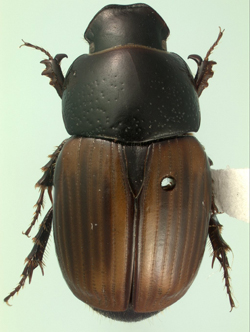 |
|||||||
|
|||||||
Diapterna Horn 1887
Diapterna Horn 1887: 4.
Photo by P. Skelley.
|
||
|
||
| Aphodiinae Overview | ||
| Aphodiini Key |
Type species. Aphodius hamatus Say 1824: 277, by subsequent designation.
Diagnosis. Body length 5.4-8.0 mm, elongate, robust, black with elytra black to variably marked in yellow, or elytral nearly entirely yellowish. Head smooth, lacking tubercles. Head and pronotal punctures widely separated, unevenly distributed. Metatibial apical spinules unequal in length; superior metatibial spur longer than basal tarsal segment. Male with protibial spur and basal metatarsal segment modified.
Distribution. North America into Mexico.
Composition. Diapterna contains 6 species.
Diapterna dugesi (Bates 1887: 83) [Aphodius], Mexico.
= Diapterna dugesi ab. grossus Dellacasa 1986: 235.
Diapterna hamata (Say 1824: 277) [Aphodius], S-Canada, W-USA.
= Aphodius garmani Brown 1929: 227.
= Aphodius occidentalis Horn 1870: 114.
Diapterna hyperborea (LeConte 1850: 225) [Aphodius], NE-USA, S-Canada.
= Aphodius angularis LeConte 1850: 225.
= Aphodius sagittarius Harold 1860: 615.
Diapterna omissa (LeConte 1850: 103) [Aphodius], SW-Canada, NW-USA.
= Aphodius torpidus Horn 1870: 114.
Diapterna pinguella (Brown 1929: 228) [Aphodius], SW-Canada, NW-USA.
= Aphodius pingellus Brown 1929: 228, misspelling.
Diapterna pinguis (Haldeman 1848: 103) [Aphodius], N.Central-USA to SE-Canada.
= Aphodius validus Horn 1870: 112.
Life History. Most members of Diapterna appear to live in moist, organically rich soils, possibly feeding on the accumulated decaying organic matter. Diapterna dugesi lives in detritus piles of leaf cutter ants (Atta sp.).
Larvae. The larva of D. hamata is described in Ritcher (1966).
References:
Dellacasa, G. 1986. A world-wide revision of Aphodius sharing a large scutellum (Coleoptera Scarabaeidae Aphodiinae). Frustula Entomologica, Nuova Serie 7-8: 173-282.
Gordon, R. D., and P. E. Skelley. 2007. A monograph of the Aphodiini inhabiting the United States and Canada (Coleoptera: Scarabaeidae: Aphodiinae). Memoirs of the American Entomological Institute 79: 580 pp.
Ritcher, P.O. 1966. White grubs and their allies: A study of North American scarabaeoid larvae. Oregon State University Press, Corvallis, Oregon. Studies in Entomology 4: 219 pp.
|
||||
| Author: Paul Skelley Generated on: 01/MAY/08.....Last modified: 01/MAY/08 University of Nebraska State Museum - Division of Entomology |
